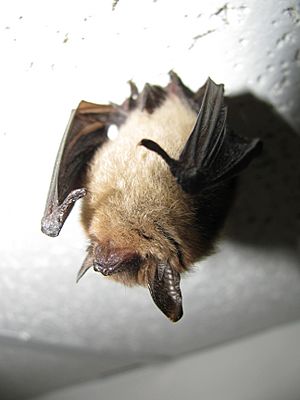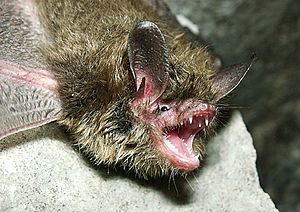Myotis septentrionalis facts for kids
Quick facts for kids Myotis septentrionalis |
|
|---|---|
 |
|
| Conservation status | |
| Scientific classification | |
| Genus: |
Myotis
|
| Species: |
septentrionalis
|
 |
|
| Range of M. septentrionalis | |
| Synonyms | |
|
Myotis keenii septentrionalis |
|
The northern long-eared bat (also called Myotis septentrionalis) is a small bat that lives in North America. It's known for its long ears, which help it stand out from other bats in its family. These bats are usually found in the northern United States and southern Canada. They live in many different states, about 37 in total.
Contents
What Does the Northern Long-Eared Bat Look Like?
The northern long-eared bat is quite small. It measures about 8.6 cm (3.4 in) from its head to the tip of its tail. Its tail alone is about 4 cm (1.6 in) long. Adult bats weigh between 5 and 8 g (0.18 and 0.28 oz), which is about the weight of a few paperclips!
Key Features of This Bat
These bats have light brown fur and wings. They don't have dark spots on their shoulders like some other similar bats. Their most special feature is their long ears. When you fold an ear forward, it goes past the bat's nose! They also have a long, pointed part inside their ear called a tragus.
How Their Body Helps Them Fly
Northern long-eared bats have a longer tail and bigger wings compared to other bats their size. This helps them fly very well, especially when they need to move slowly or turn quickly in tight spaces.
Where Do Northern Long-Eared Bats Live?
Northern long-eared bats live across a large area. You can find them in the eastern half of the United States and Canada. Their range stretches from Manitoba and Newfoundland in the north down to North Carolina and Alabama in the south. Sometimes, they are also seen in western Canada, like in British Columbia.
Their Favorite Homes
These bats mostly live in forests. They especially like boreal forests, which are forests with lots of evergreen trees. During the summer, they often rest in hardwood trees.
How Do Northern Long-Eared Bats Live?
During spring and summer, northern long-eared bats spend their days sleeping. They often rest in trees or sometimes in man-made buildings. They like to switch their resting spots, moving to a new place almost every other day.
Summer Roosts and Maternity Colonies
Their resting trees are usually close to each other. They are also near areas where the bats can find food. Male bats and females who are not having babies usually rest alone or in small groups. But female bats who are having babies form much larger groups called maternity colonies. These groups can have up to sixty bats!
Winter Hibernation
When fall arrives, northern long-eared bats fly to caves to hibernate. Hibernation is like a very long sleep that helps them save energy during winter. This can happen anytime between September and November, depending on how far north they live. They wake up and leave the caves between March and May.
Where They Hibernate
They often hibernate with many other types of bats. Even so, groups of northern long-eared bats can still number in the hundreds in these caves.
What Do Northern Long-Eared Bats Eat?
Northern long-eared bats are great at finding food inside forests. They use special sounds called echolocation to navigate. These sounds are short, quiet, and high-pitched. This helps them fly through trees and find insects.
Their Diet and Hunting Style
Their main food is moths. But they also eat other insects like beetles and flies. What's cool is that they don't usually catch insects while flying. Instead, they "glean" them, which means they pluck the insects right off surfaces like leaves or tree trunks. They usually hunt under the forest trees or at the edges of forests. Most of their hunting happens in the first two hours after the sun sets.
Life Cycle and Reproduction
Mating for northern long-eared bats happens between July and early October. However, the female bats store the male's sperm over the winter. They only become pregnant in the spring.
Birth and Growth of Young Bats
Baby bats are born between May and early July, depending on the location. The young bats usually grow to their full size by the end of August. These bats can live for a long time in the wild, sometimes for over eighteen years!
Why Are Northern Long-Eared Bats in Danger?
The biggest threat to northern long-eared bats is a disease called white-nose syndrome. This disease has caused a huge drop in their numbers, especially in the northeastern part of their range. In some areas, their population has gone down by 99%!
Protection Efforts
Because of white-nose syndrome, the United States Fish and Wildlife Service (USFWS) has listed the northern long-eared bat as a "Threatened" species. This means they are protected by law.
Protecting Hibernation Sites
One example of protecting these bats is in Wisconsin. The Elroy-Sparta Bike Trail has tunnels where these bats hibernate. These tunnels are closed by early November to protect the bats. There was a discussion about when to close the tunnels because a marathon used them. To help the bats, the marathon organizers moved their event date earlier in October so the tunnels could be closed sooner.



